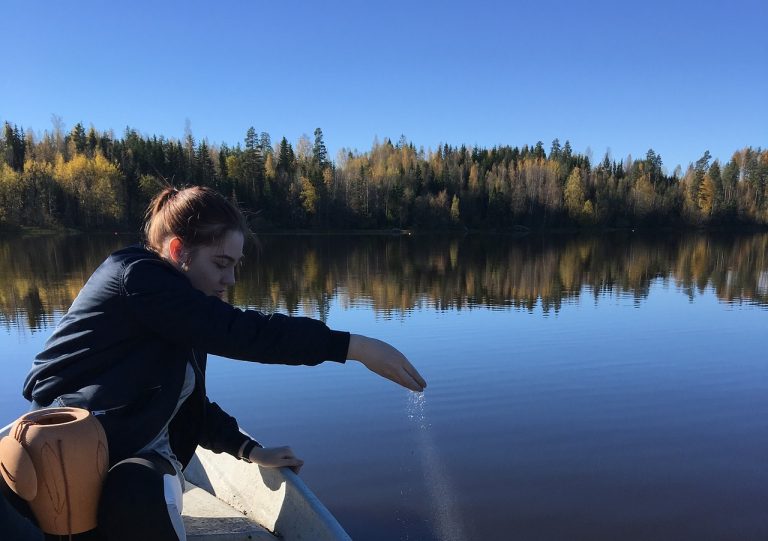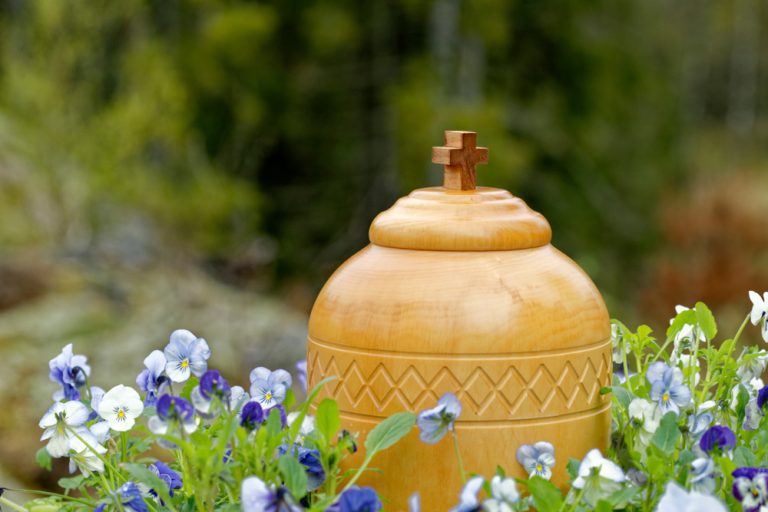Water Cremation
What is Water Cremation?
Water cremation — also known as alkaline hydrolysis, aquamation, natural water cremation, hydro cremation, resomation, bio cremation, or flameless cremation — is an innovative and environmentally friendly alternative to traditional cremation. In this article, we’ll explain how the process works in a way that anyone, with or without a scientific background, can understand, and exactly why it’s a more eco-conscious option.
The science behind alkaline hydrolysis
At its simplest, the process of water cremation gently transforms the deceased into eventual ashes through a combination of water, heat, and alkaline chemicals. It was originally developed for pets, but is increasingly gaining acceptance for humans.
Preparation
The process begins by placing the deceased in a specialized, stainless-steel vessel. This is then filled with a solution containing water and alkali, typically potassium hydroxide (KOH). The alkaline solution is heated to approximately 300 degrees Fahrenheit (150 degrees Celsius).
Decomposition begins
Over the course of several hours, the combination of heat, water and alkaline chemicals enables decomposition. Unlike traditional cremation, which uses high temperatures to oxidize the body, alkaline hydrolysis relies on a chemical reaction to break down the organic matter.
Transformation
As the process unfolds, the body’s tissues — including proteins, fats, and carbohydrates — undergo hydrolysis. This means that they are chemically broken down into their fundamental components. The result is a sterile, amber-colored liquid that contains amino acids, peptides, sugars, and salts. The only solids that remain are the bones.
How long does water cremation take?
Flameless cremation typically takes between 4 to 12 hours, but may take as long as 18 or 20 if undertaken at a lower temperature of 200 degrees Fahrenheit (approximately 95 degrees Celsius). This is considerably longer than traditional cremation which, due to the far higher temperatures, usually takes between 90 minutes and 2 hours.
What happens to the liquid residue?
The liquid left after the water cremation process is completely safe for the environment. It is treated and released into the wastewater system, where it is eventually returned to the natural water cycle. The process adheres to all environmental regulations and safeguards.
What happens to the bones?
After aquamation, the bones are left much softer and more brittle than after traditional cremation. They are removed from the water cremation vessel and are then processed into ashes. On average, loved ones will receive 20 to 30 percent more ashes than they would with traditional cremation, which they can then keep in an urn, bury in a tree burial, or scatter.


The environmental benefits of aquamation
Hydro cremation is celebrated for its minimal environmental impact. It has the following eco-friendly advantages:
- Reduced energy consumption. Unlike traditional cremation which requires high temperatures exceeding 1,800 degrees Fahrenheit (1,000 degrees Celsius), water cremation operates at significantly lower temperatures. This dramatically reduces energy usage (by between 70 to 90 percent) and burns no fossil fuels.
- Fewer harmful emissions. Traditional cremation releases harmful gases into the atmosphere, including carbon dioxide and mercury. In contrast, water cremation emits no toxic gases. Because the process is completed at a lower heat, the mercury from dental fillings is not released into the air.
- Elimination of embalming chemicals. Alkaline hydrolysis eliminates the need for embalming fluids, which typically contain toxic chemicals such as formaldehyde. As a result, it helps to prevent soil and groundwater contamination.
Some concerns have been raised that aquamation uses large amounts of water (about 100 gallons, or 375 litres). However, the average American family uses more than 300 gallons (1,100 litres) of water per day at home, so in comparison, the usage is small and the environmental benefits are still substantial.
Other little-known benefits of aquamation
Traditional cremation produces ashes that are grey and coarse. However, as well as resulting in more ashes — which might be useful for large families where each member would like to receive some ashes to remember their loved one by, or where the deceased wished to have their ashes scattered in several locations — the aquamation process results in ashes that resemble a fine white powder.
Another benefit is that pacemakers don’t need to be removed from a body before water cremation. With traditional cremation, pacemakers need to be taken out as the battery in the pacemaker might explode at the high temperatures required. However, with aquamation, there is no risk of the battery exploding.
Medical implants made of metal are not destroyed in the aquamation process. Instead, they are cleaned and sterilized, and can be recycled by metal refineries and made into new materials.
How much does water cremation cost?
The exact cost will obviously vary based on your location and your funeral provider, but alkaline hydrolysis is usually slightly more expensive than traditional cremation. However, it is considerably cheaper than a traditional burial as there’s no need to purchase a burial plot or pay for a headstone. It’s also useful to note that no casket is required for the water cremation process; the body is typically placed in a special biodegradable bag or wrapped in a natural wool or silk shroud. This is in contrast to a traditional cremation (where a completely combustible casket of other cremation vessel is required) or traditional burial.
Which religions accept water cremation?
Catholicism appears not to be accepting of water cremation, however it’s usually permitted in other Christian faiths. Desmond Tutu, winner of the Nobel Peace Prize and the former Anglican Archbishop of Cape Town, was a high-profile supporter of the process, choosing aquamation as his own end-of-life process when he passed away in 2021.
Buddhists and Sikhs traditionally prefer cremation, and so are usually accepting of aquamation. While Hindus also traditionally practice cremation, there is a focus in Hinduism on the fire of the funeral pyre (traditional practice in India) or cremation chamber releasing the soul into the air. With aquamation, nothing is actually “released”, so this may be a consideration that makes it less acceptable for some Hindus.
In both Judaism and Islam, burial is the accepted way for a person to be laid to rest, and both traditional cremation and aquamation would be considered disrespectful to the body.
Where is water cremation legal?
Aquamation is legal for humans in many states of America and several provinces of Canada, as well as Costa Rica, Mexico, South Africa and parts of Australia. In other parts of the world, many countries are considering amendments to their laws that would make the process of water cremation for humans legal. In the U.K., the company Resomation is committed to making the process available and accessible. They currently manufacture “resomaters” and export them around the world, and the first Resomation facility is expected to open in England later this year.
Conclusion
As we journey through life, it is essential to consider not only how we live, but also how we say our final goodbye. Water cremation represents a gentle and sustainable choice that is gaining increasingly widespread acceptance, and which is also a cost-effective choice, especially when compared to the cost of a traditional burial.

